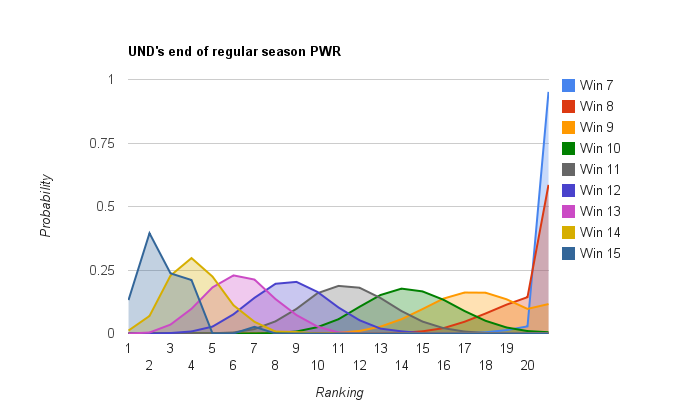UND fans accustomed to slow starts might be tempted to brush off this season’s slow start as inconsequential, but should they?
January is the typical time to start paying attention to the PairWise Rankings (PWR) that mimic that NCAA’s tournament selection criteria. UND’s current PWR ranking is #19, which would not be sufficient to make the NCAA tournament, but the season isn’t over, so how much does that matter?
Some humorously early bracketology discussions in recent years led me to write an essay a couple years ago, When to start looking at PWR. In short, PWR is so volatile as to be almost meaningless before January; also, PWR doesn’t become a very good predictor of the end-of-season PWR (the only one that matters) until March. So, rather than write much more about today’s PWR ranking, I’ll spend the rest of this article focusing on where UND’s PWR could be in March.
UND’s 2011-12 PWR vs. past performances
UND’s current PWR ranking of 19 is the second worst for a Hakstol-era UND team at this time of year.
2008 – non-TUC (climbed to #5 at the end of the WCHA play-in round with a 15-2-3 run, fell to #8 after getting swept out of the WCHA tournament)
2006 – #18 (climbed to #10 at the end of the WCHA play-in round with a 12-2-4 run, to #7 with a win and a loss in the WCHA tournament)
Each of those teams made the NCAA tournament, but only after a phenomenal second half run.
Where will UND finish?
Mathematically, UND can still finish the regular season #1 overall even if they lose one more game.
The above graph is the distribution of rankings, given how many of its remaining games wins. So, for example, the gray “Win 11” curve shows that UND is quite likely to have a PWR ranking of 10-13 at the end of the regular season if they win 11 of their remaining games.
Making the NCAA tournament is a distinct possibility. If you guess at a PWR ranking of 13 as the cutoff for making it at large (it depends how many lower-ranked teams get autobids, thus taking one of the 16 slots), winning 8 or 9 of the remaining 15 games could be sufficient with a decent WCHA tournament run.
Technical note on PWR (change in COP)
For students of PWR, you should note one change in the way PWR is calculated this year.
Rather than the common opponents (COP) criterion simply being a sum of each teams’ records vs all common opponents, it’s the average of each teams’ record vs each common opponent. That’s a subtle distinction, so I’ll try to illustrate it with a hypothetical example which highlights the reason they made this change.
Suppose these outcomes:
UND vs Sacred Heart: 5-0-0
UND vs Ohio State: 0-1-0
Minnesota vs Sacred Heart: 1-0-0
Minnesota vs Ohio State: 3-2-0
Old COP would be: UND 5-1-0 (.8333) / Minnesota (.6667)
New COP would be: UND .500 (average of 100% and 0%) / Minnesota .800 (average of 100% and 60%)
In short, the old formula rewarded UND for having more games against the easier opponent, despite having been winless vs the other common opponent. The new formula gives Minnesota the COP comparison for having winning records vs. both opponents.
I just stumbled on this, how is PWR being predicted?
I simulate the outcomes of the remaining games in the season a million or so times, using KRACH to predict the likelihood of each team winning in each iteration. That’s enough simulations to ensure that even the most unlikely possibilities occur at least once. For each simulated season I calculate what PWR would result from that set of outcomes. I then use the aggregate results of those simulations to assign a likelihood to a particular outcome, that is, if UND finishes #3 in PWR in 370,000 of 1,000,000 simulations, I say that UND has about a 37% chance of finishing #3.
Closing remarks
This is my first stab at firing up the PWR simulations and writing this sort of post this year. It does always seem to take me a little while to get back into the groove, so please point out any errors, questions, or points that need clarifying.
Though I started with an analysis of UND’s position, let me know if there’s anything else in particular that you’d like to see.
Resources
- Current PWR Rankings (SiouxSports.com)
- Explanation of how PWR mimics NCAA tournament selection (CollegeHockeyNews.com)
- Change to COP calculation in PWR formula (USCHO.com)
